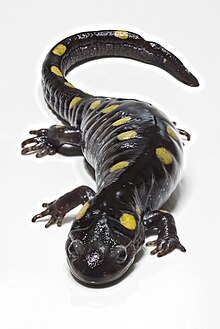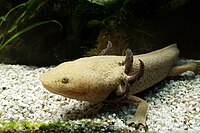Mole salamander
This article needs additional citations for verification. (October 2008) |
| Mole salamanders | |
|---|---|

| |
| Spotted salamander (Ambystoma maculatum) | |
| Scientific classification | |
| Domain: | Eukaryota |
| Kingdom: | Animalia |
| Phylum: | Chordata |
| Class: | Amphibia |
| Order: | Urodela |
| Family: | Ambystomatidae |
| Genus: | Ambystoma Tschudi, 1838 |
The mole salamanders (genus Ambystoma) are a group of advanced salamanders endemic to North America. The group has become famous due to the presence of the axolotl (A. mexicanum), widely used in research due to its paedomorphosis, and the tiger salamander (A. tigrinum, A. mavortium) which is the official amphibian of many US states, and often sold as a pet.
General description

All mole salamanders are
. Larvae grow limbs soon after hatching, with four toes on the fore arms, and five toes on the hind legs. Their eyes are wide-set and lack true eyelids.The larvae of some species (especially those in the south, and tiger salamanders) can reach their adult size before undergoing
Some species of mole salamanders (as well as populations of normally terrestrial species) are
Tiger salamander complex

The presence of
Several subspecies of A. tigrinum were named to deal with this problem. Recently, the barred tiger salamander (A. mavortium) was elevated to species status—covering the tiger salamander populations in the western and central United States. Several distinct subspecies still exist in A. mavortium, which may be elevated to species status at some point in the future. The California tiger salamander (A. californiense) has also been elevated out of A. tigrinum, and is actually very distantly related to all other mole salamander species. The Plateau tiger salamander (A. velasci) was elevated out of A. tigrinum through genetic analysis in 1997. All accounts referring to the axolotl (A. mexicanum) as a close relative of A. tigrinum are now considered wrong, as they are now separated by both geography and many species between. Instead, it is A. velasci, which shares the axolotl's habitat, and is probably closely related to it. The Plateau tiger salamander was probably the parent of most of the neotenic species, which raises the possibility that A. velasci is paraphyletic, and may be broken up into more species in the future.
Hybrid all-female populations
It has been suggested that this article should be split into a new article titled Unisexual salamander. (discuss) (April 2024) |
Unisexual (all-female) populations of ambystomatid salamanders are widely distributed across the Great Lakes region and northeastern North America. The females require sperm from a co‑occurring, related species to fertilize their eggs and initiate development. Usually
The nuclear DNA of the unisexuals generally comprises genomes from up to five species:
Despite the complexity of the nuclear genome, all unisexuals form a
Limb regeneration
Ambystoma mexicanum, a neotenic salamander with exceptional regenerative capabilities is one of the principal models for studying limb regeneration.[5] Limb regeneration involves the propagation of a mass of low differentiated and highly proliferative cells termed the blastema.[5][6] During limb regeneration, blastema cells experience DNA double-strand breaks and thus require homologous recombination, a form of DNA repair that deals with double-strand breaks.[6]
Taxonomy
Rhyacosiredon was previously considered a separate genus within the family Ambystomatidae. However, cladistic analysis of the mole salamanders found the existence of Rhyacosiredon makes Ambystoma
The genus name Ambystoma was given by Johann Jakob von Tschudi in 1839,[7] and is traditionally translated as "cup-mouth",[citation needed]. Tschudi did not provide a derivation for the name, and many thought that he intended the name Amblystoma, "blunt-mouth." Occasionally, old specimens and documents use the name Amblystoma. Writing in 1907, Leonhard Stejneger offered a derivation of Ambystoma based on the contraction of a Greek phrase meaning "to cram into the mouth,"[8][9] but others have not found this explanation convincing.[10] In the absence of clear evidence that Tschudi committed a lapsus, the name given in 1839 stands.
Species
This genus contains 32 species, listed below, the newest being A. bishopi. Some Ambystoma species are Terrestrial, others are neotenic, and some species have established populations of both neotenic and terrestrial forms.
| Image | Species and author | Common name | Distribution | Lifestyle | IUCN status
|
|---|---|---|---|---|---|

|
A. altamirani
Dugès, 1895 |
Mountain stream salamander, Achoque | Central Mexico, west and south of the Valley of Mexico | Terrestrial and neotenic | |
| A. amblycephalum
Taylor, 1940 |
Blunt-headed salamander | West-central Mexico (Michoacán state), near Morelia | Terrestrial and neotenic | ||

|
A. andersoni | Anderson's salamander | West-central Mexico ( Laguna de Zacapu
|
Neotenic | |

|
A. annulatum
Cope, 1886 |
Ringed salamander | South-central United States (Arkansas, Illinois, Missouri, Oklahoma), Ozark Plateau and Ouachita Mountains | Terrestrial | |

|
A. barbouri
Kraus & Petranka, 1989 |
Streamside salamander | South-midwest United States (Indiana, Kentucky, Ohio, Tennessee, West Virginia) | Terrestrial | |
| A. bishopi | Reticulated flatwoods salamander | Southeast United States ( Flint River
|
Terrestrial | ||
| A. bombypellum
(Taylor, 1940) |
Delicate-skinned salamander | Central Mexico (State of Mexico) near Jilotepec | Terrestrial | ||

|
A. californiense
Gray, 1853 |
California tiger salamander | Central Valley of California | Terrestrial | |

|
A. cingulatum
Cope, 1868 |
Frosted flatwoods salamander | Southeast United States (southern South Carolina and Georgia south to northern Florida) | Terrestrial | |

|
A. dumerilii
(Dugès, 1870) |
Lake Pátzcuaro salamander, Achoque | West-central Mexico (Michoacán state), Lake Pátzcuaro | Neotenic | |

|
A. flavipiperatum
Dixon, 1963 |
Yellow-peppered salamander, Ajolote de Chapala | West-central Mexico (Jalisco) | Terrestrial | |

|
A. gracile
( Baird , 1859)
|
Northwestern salamander | Northwest North America (southernmost Alaska to northern California) | Terrestrial | |
| A. granulosum
Taylor, 1944 |
Granular salamander, Ajolote | Central Mexico (State of Mexico) near Toluca | Terrestrial | ||

|
A. jeffersonianum
(Green, 1827) |
Jefferson salamander | Northeastern North America (Ontario south to Virginia and west to Illinois) | Terrestrial | |

|
A. laterale
Hallowell, 1856 |
Blue-spotted salamander | Northeastern North America (Nova Scotia west to Manitoba and Minnesota and south to Indiana and New Jersey) | Terrestrial | |

|
A. leorae
Taylor, 1943 |
Leora's stream salamander, Ajolote | Central Mexico ( Mount Tlaloc
|
Terrestrial | |
| A. lermaense
(Taylor, 1940) |
Lake Lerma salamander | Central Mexico (State of Mexico), Lake Lerma near Toluca | Terrestrial and neotenic | ||

|
A. mabeei
Bishop, 1928 |
Mabee's salamander | Coastal southeast United States (southeast Virginia to South Carolina) | Terrestrial | |

|
A. macrodactylum
Baird, 1950 |
Long-toed salamander | Northwest North America (Alaska south to northern California and east to Alberta and Montana) | Terrestrial | |

|
A. maculatum
(Shaw, 1802) |
Spotted salamander | Eastern North America (Nova Scotia west to Wisconsin and south to eastern Texas and Georgia) | Terrestrial | |

|
A. mavortium
Baird, 1850 |
Barred tiger salamander | Western North America (Manitoba south to Texas and west to Washington and California) | Terrestrial and neotenic | |

|
A. mexicanum | Axolotl | Central Mexico (State of Mexico), Lake Xochimilco | Neotenic | |

|
A. opacum
(Gravenhorst, 1807) |
Marbled salamander | Eastern United States (New Hampshire south to northern Florida and east to Missouri and Texas) | Terrestrial | |
| A. ordinarium
Taylor, 1940 |
Puerto Hondo stream salamander | West-central Mexico (Michoacán state), Puerto Hondo stream | Terrestrial and neotenic | ||

|
A. rivulare
Taylor, 1940 |
Michoacan stream salamander
|
Central Mexico (western State of Mexico) | Terrestrial and neotenic | |

|
A. rosaceum
Taylor, 1941 |
Tarahumara salamander | Northwest Mexico, Sierra Madre Occidental | Terrestrial and neotenic | |
| A. silvense
Webb, 2004 |
Durango salamander | Northwest Mexico (Durango and Chihuahua), Sierra Madre Occidental | Terrestrial and neotenic | ||

|
A. talpoideum
Holbrook, 1838 |
Mole salamander | Southeast United States (Virginia west to Oklahoma and south to northern Florida) | Terrestrial and neotenic | |

|
A. taylori
Brandon, Maruska, and Rumph, 1982 |
Taylor's salamander | Southeast Mexico ( Laguna Alchichica
|
Neotenic | |

|
A. texanum
Matthes, 1855 |
Small-mouth salamander | South-central United States (Ohio west to Nebraska and south to Texas and Alabama) | Terrestrial | |

|
A. tigrinum
(Green, 1825) |
Eastern tiger salamander
|
Eastern North America (New York northwest to Manitoba and south to Texas and northern Florida) | Terrestrial and neotenic | |

|
A. velasci
(Dugès, 1888) |
Plateau tiger salamander | Mexican Plateau | Terrestrial and neotenic |
In addition, two groups of unisexual hybrid populations are sometimes named under their own species:
- Silvery salamander (A. platineum)
- Tremblay's salamander (A. tremblayi)
See also
- Oophila amblystomatis
References
- ^ PMID 18498635.
- ^ PMID 17546077.
- ^ PMID 19639004.
- PMID 20682056.
- ^ a b García-Lepe UO, Cruz-Ramírez A, Bermúdez-Cruz RM. DNA repair during regeneration in Ambystoma mexicanum. Dev Dyn. 2021 Jun;250(6):788-799. doi: 10.1002/dvdy.276. Epub 2020 Dec 17. PMID 33295131
- ^ a b García-Lepe UO, Torres-Dimas E, Espinal-Centeno A, Cruz-Ramírez A, Bermúdez-Cruz RM. Evidence of requirement for homologous-mediated DNA repair during Ambystoma mexicanum limb regeneration. Dev Dyn. 2022 Jun;251(6):1035-1053. doi: 10.1002/dvdy.455. Epub 2022 Jan 25. PMID 35040539
- ^ Tschudi, Johann Jakob (1839). "Classification der Batrachier, mit Berucksichtigung der Fossilen Thiere dieser Abtheilung der Reptilien". Mémoires de la Société des Sciences Naturelles de Neuchatel. 2 (4): 57, 92.
- .
- PMID 17793100.
- S2CID 5490505.
External links
![]() Data related to Ambystomatidae at Wikispecies
Data related to Ambystomatidae at Wikispecies
![]() Media related to Ambystoma at Wikimedia Commons
Media related to Ambystoma at Wikimedia Commons

